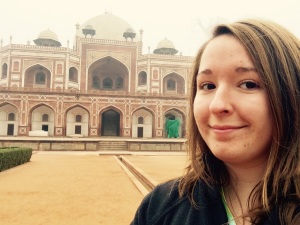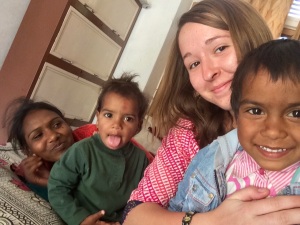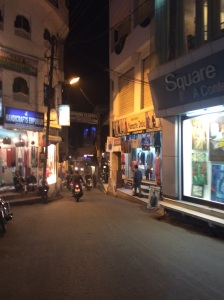“You must do the thing you think you cannot do” -Eleanor Roosevelt.
My first two weeks in India have been a challenging and wonderful adventure.
I learned a lot about my fellowship project by spending time at a safe house for women and children escaping domestic violence, a school for children with hearing challenges, and a picnic day for families and children who participate in different NGO programs.
Personally my time in India so far has been a whirlwind of different emotions as I experienced challenges; culture shock; a high fever and hospital visit; three weddings; motorcycle rides through the city; delicious meals at rooftop restaurants with stunning views; and adventures exploring the cultural, historical, and architectural heritage of a unique area of the world.
Even from the very first day, India has tested my personal strength, courage, and resilience as I struggled to overcome an illness and adapt to a different country, culture, and way of life.
I felt overwhelmed the moment I stepped off of the plane at Delhi International Airport.
I hardly slept on my two plane rides and I was feverish, exhausted, weak, and drained of energy.
Little did I know, I was stepping into a completely different world.
The security around the hotel and the Aerocity complex was like nothing I had ever experienced.
There was a man sitting at the entrance to the hotel Aerocity complex with sandbags around him and a rifle pointed out at the main road. When I arrived at the gate of the Holiday Inn, armed security officers approached the car with scanning devices and checked under the car, the front hood, and the rear trunk.
When I exited the car and approached the entrance to the hotel, I was ushered into a security line where my luggage was scanned, I walked through a metal detector, and my body was patted down.
With a high fever, jet lag, and a desperate need for sleep I struggled to understand what was happening around me. Why were they searching all of my bags? Why do they need so much security for a hotel? Where am I?
I sluggishly made my way to the check-in counter, received my skey, stumbled up to my room, and collapsed on my bed.
All of this security and recent stories about India from friends and travelers made me anxious.
Even though I wasn’t sure what my next few days or month in India would be like, I thought about everything I had experienced during my fellowship year so far and I felt reassured that I could handle any situation that I would encounter.
I had solid contacts with an NGO in Udaipur; I would be staying with local and foreign volunteers on the NGO’s main campus; and I would have the advice, guidance, and support of many people in the NGO and local community throughout my time in India.
Despite feeling more and more sick as the night progressed, I planned a five hour tour of Delhi with the help of a chauffeur driver that I hired through my hotel so that I could explore as much of the city as possible during my layover.
The next morning I sat in the back seat of the car I hired, boiling from my high fever, and sipping on a large water bottle as my driver showed me around Delhi.
I struggled to process everything that was happening around me as I entered a completely different and unfamiliar world.
I saw children playing in the street with no shoes and ripped clothing. I saw many homeless people trying to sleep on the road, on the sidewalk, in abandoned buildings, and along the top of concrete walls that bordered different city properties.
The streets were littered with garbage and on this chilly morning many people were collecting the garbage into little piles along the side of the road and setting the piles of garbage on fire in order to stay warm. Cows and herds of stray dogs were also walking free in the streets, stopping occasionally to munch on the garbage.
The roads and alleyways were congested with old public transportation buses, people, motorbikes and small vehicles called rickshaws or tuk-tuks.
As I sat and watched my driver navigate through the traffic, I was fascinated by the traffic patterns and the nature of driving in the city.
It was complete chaos.
There was very little order to how vehicles drove on the streets and there were not any differentiated lanes of traffic as cars and motorbikes moved around larger vehicles in a disorganized manner.
My attempt to nap in the car was continuously interrupted by high-pitched and elaborate honks and beeps as every car blared its horn seemingly without a clear purpose.
In a fever-induced daze I was overwhelmed by everything that I saw.
The amount of people, the degree of poverty, the visibility of social problems and suffering, and the differences in customs and ways of life were all more than I had expected.
Despite the overwhelming new experiences, sights, and smells, I was fascinated by everything that I encountered.
As I continued my car ride and journey around New Delhi and Old Delhi, I was comforted by stunning sights of architecture and culture as well as beautiful moments showing the strong and compassionate nature of the human spirit.
I saw a man help his children into a tiny vehicle with their school backpacks. After he somehow managed to fit all eight children into a tiny wagon-box, he then mounted his bicycle and carried their weight through the streets to bring them to school.
In the busy hustle and bustle of the largest market in Delhi, I saw so many people helping each other.
I watched families stop at different produce stands and work together to pick out different vegetables and fruits. I also saw a young man assist an older woman as she struggled to carry her goods through the market.
As the car made its way into more residential areas I saw children playing in the streets, laughing, and smiling as they chased each other.
I was also fascinated by how the city looked.
Homes and old buildings lined the streets, a market was set up on the sides of a large and wide dirt road, and the main tourist sights were gated and guarded.
I was amazed by the beauty of a temple called Swaminarayan Akshardham, the beauty and size of the largest and oldest mosque in India, the stunning architecture of the historic Red Fort, and the gorgeous sights at Humayun’s Tomb.
I then returned to the hotel in time to gather my things and leave for my short journey to Udaipur.
When I arrived at Udaipur airport, I took a taxi to the international NGO’s campus and spent the afternoon and night fighting through a difficult fever.
With my fever reached 104.5 degrees Fahrenheit the next morning, I took a small auto to a hospital called the “American Hospital” and was prescribed five different medications to help me overcome a bad case of tonsilitis.
I then spent the next few days in bed sleeping and fighting off my fever.
In-between bouts of shaking, shivering, and coughing, I came to the unfortunate realization that this was the third time that I had tonsilitis in the past six months of my journey.
I was worried about what my health would be like for the rest of my trip since this was my worst case of tonsilitis yet and I was advised by the doctor at the hospital that my tonsils should be removed as soon as possible.
For several days I considered interrupting my trip to travel home and have my tonsils removed. I was afraid of what could happen if I continued to get tonsilitis during my journey; I was especially worried about what would happen if I became sick when I was in a remote part of a country without quick and easy access to medical care.
Once I started to feel better and could think clearer, I ultimately decided against interrupting my travels to go home for a tonsillectomy. Instead I decided to try to get antibiotics prescribed so that I would have the medicine that I would need if I developed tonsilitis again in a place without easily accessible medical care.
After resting for a few days, I finally began to explore the local area and the different NGO programs.
I spent nearly every day of my first week with the only women’s shelter in Udaipur, a short term stay safe house that was housing about ten women and four children who were survivors of domestic violence.
Unfortunately, my first impression of the safe house was not very positive.
Despite visiting the shelter at different times each day, I was surprised and disappointed to see that there were no programs or activities to help these women and children. After spending time at the shelter and talking to other volunteers, I realized that the women and children spent their days doing chores and laying around the shelter complex.
Despite an organization mandate and plan to provide services, the families at the shelter were not receiving counseling, vocational training, or services that could help them overcome their experiences.
As I tried to learn more about the shelter, I heard stories about how the women’s abusers knew the location of the house and I even heard that the abusers would visit the shelter.
My first week at the safe house left me with more questions then answers.
Why were there no educational or vocational programs despite documentation stating the need for such programs? Why haven’t volunteers who visit the shelter frequently questioned the lack of programming or done something to change it? Without programs is the shelter really helping these women and children overcome their experiences? Without services is the shelter able to still effectively empower women and provide the support and guidance that they need to become independent and not return to their abusive situations?
Why were the clients at the shelter referred to as “inmates” and why were staff referred to as “wardens”? Why do families and abusers know the location of the safe house and what does that mean for the safety and wellbeing of the clients living there? Was the safe house actually safe?
As I reflected on my experiences helping domestic violence victims at home and abroad, I really struggled with one specific question: what can I do in my limited time here to try to help the safe house?
I wondered if it was appropriate for me to try to change and improve the safe house given the nature and goal of my fellowship. Also, I struggled to believe that I would be able to achieve effective and substantial change for this organization in the limited time that I had left in India since my visa end date was only a couple of weeks away.
Despite these limitations, I decided that I wanted to start a conversation at the NGO about the shelter and about the lack of services. While continuing to visit the shelter and other NGO programs I have also reached out to the shelter coordinator, the volunteer coordinator, fellow volunteers, and the Women’s Empowerment sector of the NGO to discuss the shelter and its lack of programming.
Hopefully during the rest of my time in India I will be able to better understand what is and isn’t happening at the safe house and then hopefully do something to help the NGO improve their services at the safe house.
Even though I have a lot of concerns about the safe house, I have really enjoyed spending time there.
I am happy that I can connect and form a bond with these women and children despite a language barrier by simply spending time with them, trying to communicate, playing, and dancing.
As they begin to open up to me I am learning so much about their ways of life; their stories; and most importantly I am learning about them as mothers, daughters, and individual people.
I am very thankful for the opportunity to get to know these women and children, their unique personalities, their supportive and nurturing spirits, their bright sense of humor, and their strength.
One of my favorite moments in India so far was when we all left the safe house and went to a park for an NGO event that brought together women, children, and families involved in different NGO programs.
The families from the safe house were all dressed up for the event and I had never seen them so happy and excited.
It was incredible to be a part of this wonderful day for the families as I was able to see them interact, run, smile, laugh, and play.
I enjoyed running around with the kids, watching the children participate in different games, playing with the kids on the playground and making them “fly” with the spin toy, and spending more time individually with many of the women.
From taking funny pictures of climbing a fake horse to sharing meals together and dancing in front of the crowd, there are so many memories from that day that I will never forget.
I am also thankful for all of the new adventures that I have had in India.
I hiked several kilometers (in flip flops) through a wildlife preserve to the gorgeous Monsoon Palace.
I explored the city of Udaipur and visited the main City Palace.
I ate incredible (mostly vegetarian) meals at rooftop restaurants with stunning views of the city.
I attended and celebrated three weddings in one week.
And I have met wonderful people who have helped make India an unbelievable experience.
With only a short time left in India, I am excited to continue to learn and to explore!



























































Hi Ashley.
I’m a long-ago Bryn Mawr grad (class of ’84) and a frequent India traveler (went to highschool there and go back every year). Sounds like you won’t be there much longer, but if you need someone to listen to your experiences, answer questions or help as best I can from the US, let me know.
LikeLike